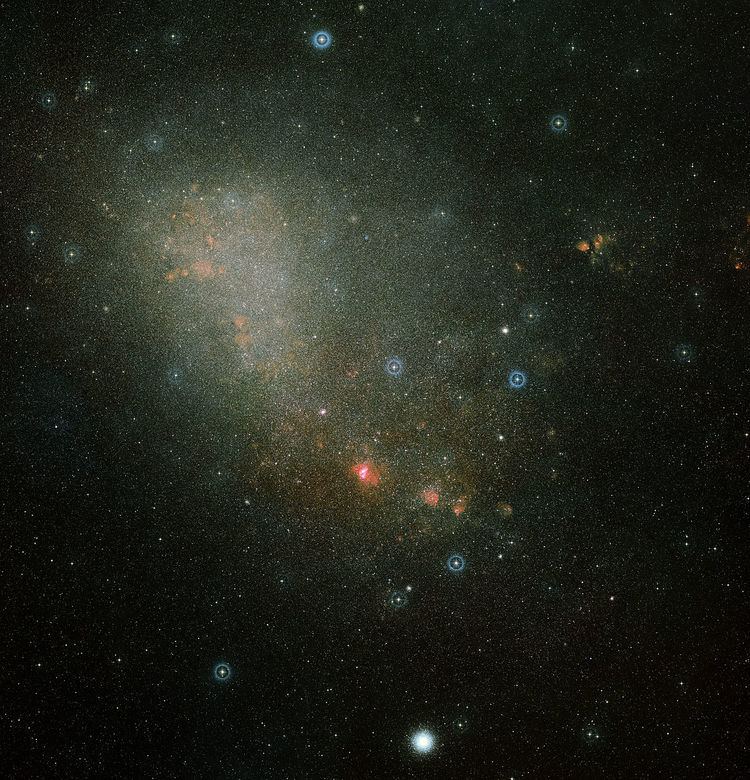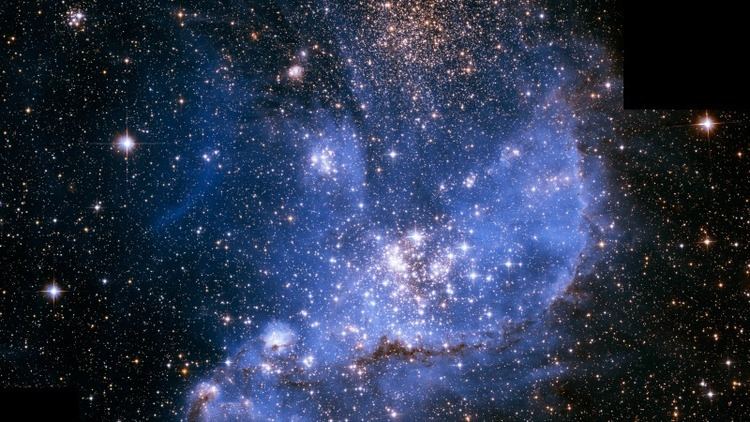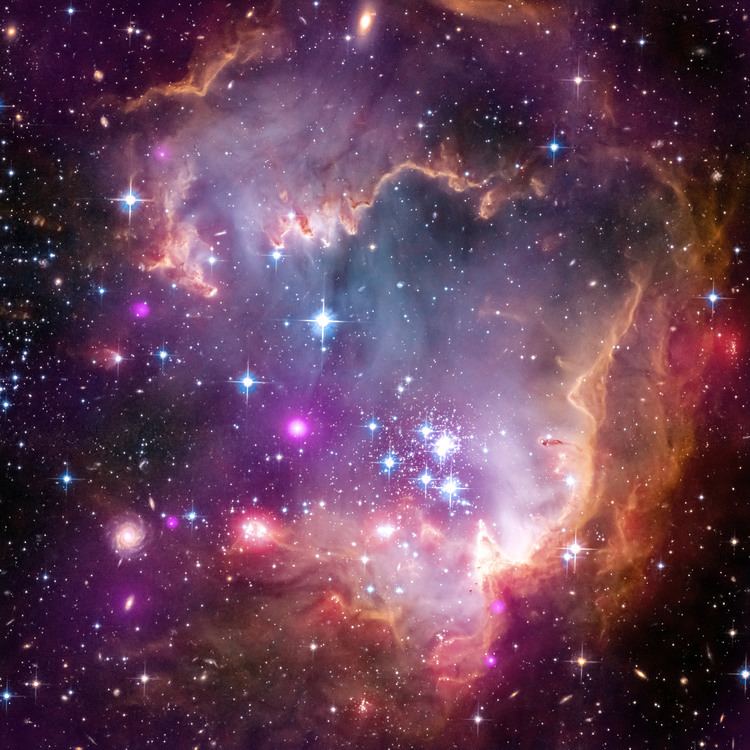Right ascension 00 52 44.8 Redshift 158 ± 4 km/s Size 7,000 ly (diameter) Distance to Earth 199,000 light years Magnitude 2.7 Apparent magnitude (V) 2.7 | Declination −72° 49′ 43″ Type SB(s)m pec Apparent size (V) 5° 20′ × 3° 5′ Apparent mass ~6.5 billion M☉ | |
 | ||
Similar | ||
Small magellanic cloud tour
The Small Magellanic Cloud (SMC), or Nebucula Minor, is a dwarf galaxy near the Milky Way. It is classified as a dwarf irregular galaxy. It has a diameter of about 7,000 light-years, contains several hundred million stars, and has a total mass of approximately 7 billion times the mass of the Sun. The SMC contains a central bar structure and it is speculated that it was once a barred spiral galaxy that was disrupted by the Milky Way to become somewhat irregular. At a distance of about 200,000 light-years, it is one of the Milky Way's nearest neighbors. It is also one of the most distant objects that can be seen with the naked eye.
Contents
- Small magellanic cloud tour
- Teach astronomy small magellanic cloud
- Observation history
- Features
- Mini Magellanic Cloud MMC
- References

With a mean declination of approximately −73 degrees, it can only be viewed from the Southern Hemisphere and the lower latitudes of the Northern Hemisphere. It is located mostly in the constellation of Tucana and also partly in Hydrus and appears as a hazy, light patch in the night sky about 3 degrees across, looking like a detached piece of the Milky Way. Since it has a very low surface brightness, it is best viewed from a dark site away from city lights. It forms a pair with the Large Magellanic Cloud (LMC), which lies a further 20 degrees to the east, and like the LMC is a member of the Local Group.

Teach astronomy small magellanic cloud
Observation history

In the southern hemisphere, the Magellanic clouds have long been included in the lore of native inhabitants, including south sea islanders and indigenous Australians. Persian astronomer Al Sufi labelled the larger of the two clouds as Al Bakr, the White Ox. European sailors may have first noticed the clouds during the Middle Ages when they were used for navigation. Portuguese and Dutch sailors called them the Cape Clouds, a name that was retained for several centuries. During the circumnavigation of the Earth by Ferdinand Magellan in 1519–22, they were described by Antonio Pigafetta as dim clusters of stars. In Johann Bayer's celestial atlas Uranometria, published in 1603, he named the smaller cloud, Nubecula Minor. In Latin, Nubecula means a little cloud.

Between 1834 and 1838, John Frederick William Herschel made observations of the southern skies with his 14-inch (36 cm) reflector from the Royal Observatory at the Cape of Good Hope. While observing the Nubecula Minor, he described it as a cloudy mass of light with an oval shape and a bright center. Within the area of this cloud he catalogued a concentration of 37 nebulae and clusters.

In 1891, Harvard College Observatory opened an observing station at Arequipa in Peru. Between 1893 and 1906, under the direction of Solon Bailey, the 24-inch (610 mm) telescope at this site was used to survey photographically both the Large and Small Magellanic Clouds. Henrietta Swan Leavitt, an astronomer at the Harvard College Observatory, used the plates from Arequipa to study the variations in relative luminosity of stars in the SMC. In 1908, the results of her study were published, which showed that a type of variable star called a "cluster variable", later called a Cepheid variable after the prototype star Delta Cephei, showed a definite relationship between the variability period and the star's luminosity. This important period-luminosity relation allowed the distance to any other cepheid variable to be estimated in terms of the distance to the SMC. Hence, once the distance to the SMC was known with greater accuracy, Cepheid variables could be used as a standard candle for measuring the distances to other galaxies.
Using this period-luminosity relation, in 1913 the distance to the SMC was first estimated by Ejnar Hertzsprung. First he measured thirteen nearby cepheid variables to find the absolute magnitude of a variable with a period of one day. By comparing this to the periodicity of the variables as measured by Leavitt, he was able to estimate a distance of 10,000 parsecs (30,000 light years) between the Sun and the SMC. This later proved to be a gross underestimate of the true distance, but it did demonstrate the potential usefulness of this technique.
Announced in 2006, measurements with the Hubble Space Telescope suggest the Large and Small Magellanic Clouds may be moving too fast to be orbiting the Milky Way.
Features
There is a bridge of gas connecting the Small Magellanic Cloud with the Large Magellanic Cloud (LMC), which is evidence of tidal interaction between the galaxies. The Magellanic Clouds have a common envelope of neutral hydrogen indicating they have been gravitationally bound for a long time. This bridge of gas is a star-forming site.
In 2017, using Dark Energy Survey plus MagLiteS data, a stellar over-density associated with the Small Magellanic Cloud was discovered, which is probably the result of interactions between SMC and LMC.
Mini Magellanic Cloud (MMC)
It has been proposed by astrophysicists D. S. Mathewson, V. L. Ford and N. Visvanathan that the SMC may in fact be split in two, with a smaller section of this galaxy behind the main part of the SMC (as seen from our perspective), and separated by about 30,000 ly. They suggest the reason for this is due to a past interaction with the LMC splitting the SMC, and that the two sections are still moving apart. They have dubbed this smaller remnant the Mini Magellanic Cloud.
